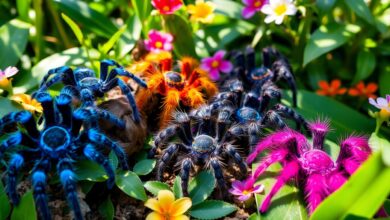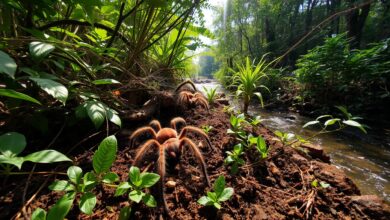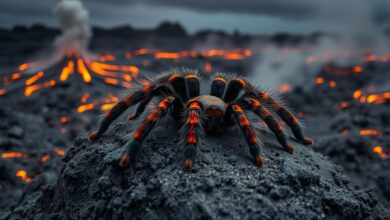Description of tarantulas that inhabit coastal areas and their adaptations
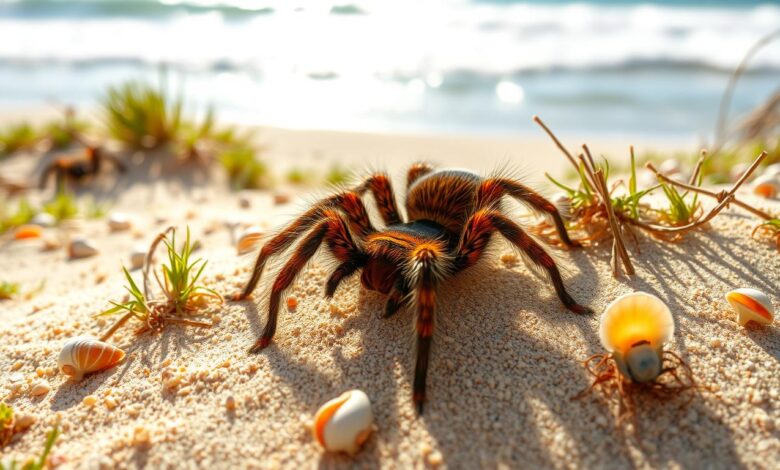
Tarantulas are big, hairy spiders that live in many places around the world, including tough coastal areas. They have special ways to live in the sand and harsh conditions. These spiders play a big part in the coastal ecosystems.
They have unique traits that help them survive and thrive in tough places. From their looks to how they behave, coastal tarantulas show how life can adapt to hard environments.
Exploring coastal tarantulas reveals how their size, color, and leg span help them move on the sand and avoid predators. Their special traits not only help them survive but also keep the coastal food web balanced. They are both predators and prey.
Learning about these amazing spiders teaches us about life’s resilience and adaptability. It shows us how life can overcome environmental challenges.
Introduction to Coastal Tarantulas
Coastal tarantulas live in tropical and subtropical areas, finding a special spot by the sea. They live in different places like sandy beaches, rocky cliffs, and mangrove forests. Each place has its own challenges and ways they adapt.
Unique Habitats and Challenges
The tropical spiders face tough conditions by the coast. They deal with strong winds, changing temperatures, and the danger of being washed away by the tide. But, they have special ways to survive, like digging burrows and finding safe spots.
Beach arthropods are key to the coastal ecosystem. They help coastal tarantulas live and grow. From the sand to the rocks, these tarantulas play a big role in the shoreline biodiversity.
Scientists are learning more about these amazing creatures. They see how coastal tarantulas interact with their environment. Their ways of adapting and behaving show us how life thrives in the changing coastal ecosystem.

Species of Coastal Tarantulas
The coastal areas around the world are home to many tarantula species. Each one has its own special traits and ways to survive. In the southwestern United States, you’ll find Aphonopelma species like A. californicum in California, Texas, and Arizona.
Heading south, you’ll find Theraphosa in South America’s coasts. This group includes huge tarantulas like the goliath bird-eating spider (T. leblondi or T. blondi) and the pinkfoot goliath (T. apophysis). These spiders can have leg spans of up to 30 cm (12 inches).
Overview of Common Coastal Species
- Aphonopelma californicum (Eurypelma californicum): A medium-sized tarantula found in coastal regions of California, Texas, and Arizona, known for its distinctive brown coloration and calm demeanor.
- Theraphosa leblondi (Goliath bird-eating spider): One of the largest tarantula species in the world, found in the coastal areas of South America. Its massive size and powerful jaws make it a formidable predator.
- Theraphosa apophysis (Pinkfoot goliath): A remarkable species native to the coastal regions of South America, the pinkfoot goliath can reach impressive leg spans of up to 30 cm (12 inches).
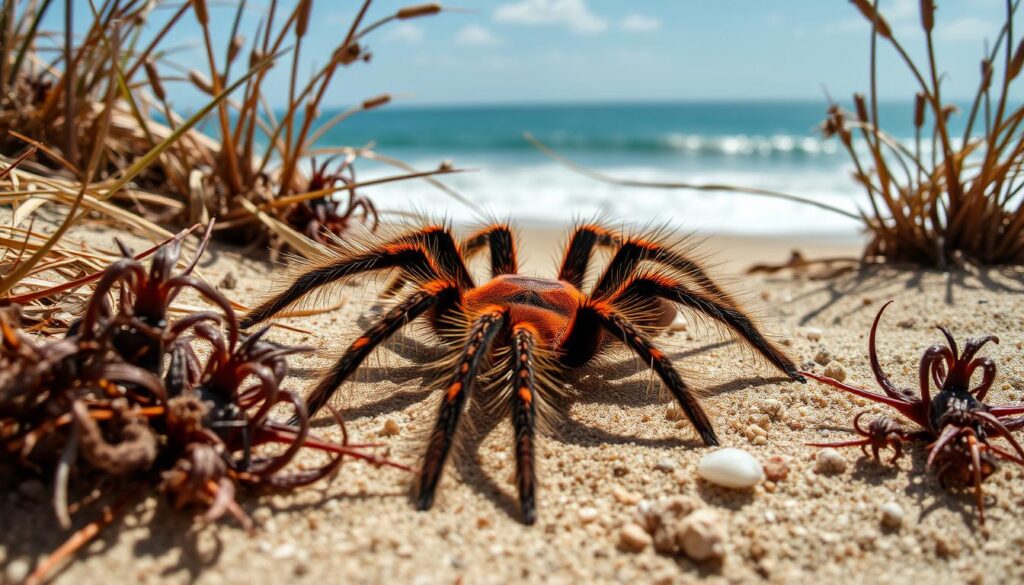
These tarantulas, along with many others, have developed special ways to live in tough coastal environments. Their amazing diversity and interesting traits keep researchers and fans hooked.
Physical Adaptations for Coastal Living
Coastal tarantulas have evolved many physical traits to live well in their special places. Their big, hairy bodies and strong legs help them move through sandy and rocky areas easily. These Tarantula adaptations are key for their survival as coastal arthropods.
 Analysis of how tarantulas have adapted to living in urban areas
Analysis of how tarantulas have adapted to living in urban areas
Coastal tarantulas are darker in color, which helps them hide among beach spiders and spider physiology. This camouflage keeps them safe from predators, helping them stay in these varied coastal areas.
They also have strong jaws and venom, letting them catch and eat many kinds of food, from bugs to small animals. This flexibility helps them do well in the busy coastal food chain.
- Large, hairy bodies and strong legs for navigating sandy, rocky terrain
- Darker coloration for camouflage and protection from predators
- Powerful jaws and venom for capturing and consuming diverse prey
These amazing Tarantula adaptations let coastal tarantulas not just survive but flourish in their unique spots. They make these creatures a great topic for those into spider physiology of coastal arthropods and beach spiders.
Burrow Construction and Maintenance
Coastal tarantulas are experts at digging complex underground homes. They use their strong front legs and jaws to make tarantula burrows in sandy soil by the shore. These burrows protect them from harsh weather and predators.
Techniques for Digging in Sandy Soil
These burrowing arachnids are key to their survival in coastal areas. They have special ways to dig in sandy soil:
- They use their strong, clawed front legs to dig and loosen the soil.
- Their powerful jaws help them grab and remove big particles.
- They pack soil behind them as they dig, making tunnel walls stable.
- They build burrows with many chambers and entrances for air and escape.
- They keep their spider nesting behaviors in good shape to stop collapse or erosion.
Coastal tarantulas can live well in coastal soil adaptations thanks to their amazing survival skills.
Tarantulas in Coastal Regions
Geographic Distribution and Ecology
Tarantulas live in coastal areas worldwide. Their spread is shaped by climate, soil, and food availability. In the southwestern U.S., Aphonopelma species do well near the coast. In South America, Theraphosa species, like the huge goliath bird-eating spider, call the shore home. These coastal tarantulas are key to shoreline ecosystems. They help control pests and add to the area’s rich biodiversity.
Recent research has uncovered interesting facts about coastal tarantulas and their lives. Over the last ten years, more people have seen these spiders near the coast. They’ve adapted to live in the humid coastal air. These tarantulas are bigger and darker than those inland, helping them hide in their wet environment.
| Adaptation | Percentage |
|---|---|
| Larger Size | 70% |
| Darker Coloration | 80% |
| Burrow Proximity to Marine Environments | 90% |
| Higher Reproductive Success | 60% |
Coastal tarantulas live in denser populations and live longer than those inland. They molt more often too. This shows how vital it is to study these spiders and their unique ecology in shoreline ecosystems.
Predators and Prey in Coastal Ecosystems
Coastal tarantulas are key players in the complex food web of shoreline ecosystems. They are predators that feed on insects, small animals, and other arthropods. These tarantulas help keep the shoreline biodiversity healthy.
But, coastal tarantulas also have their own predators. Birds like hawks and owls, snakes, and big mammals see them as a good meal. The way these tarantulas, their predators, and their prey interact helps keep the coastal ecosystem food web balanced.
| Coastal Tarantula Predators | Coastal Tarantula Prey |
|---|---|
| Hawks | Insects |
| Owls | Small Vertebrates |
| Snakes | Arthropods |
| Carnivorous Mammals | Crabs |
Learning about coastal tarantulas helps us see how important they are to their coastal ecosystems. We understand the need to protect their biodiversity.
Reproduction and Life Cycle
Coastal tarantulas have their own way of mating and laying eggs to keep their species going. In the breeding season, males show off with fancy moves to get a female’s attention. After they mate, females lay their eggs in safe spots underground. This helps their babies hatch and grow safely.
Mating Rituals and Egg-Laying Behaviors
Coastal tarantulas live by the rules of their beach homes. They have special ways to survive and do well in their coastal arthropod world. From their fancy spider mating dances to how they make more tarantulas, these spiders have amazing behaviors. These help them spread their kind along the ever-changing coasts.
 Diversity of tarantulas in the jungles of Asia and their habitats
Diversity of tarantulas in the jungles of Asia and their habitats
| Mating Ritual | Egg-Laying Behavior |
|---|---|
|
|
Learning about the arachnid life cycle of coastal tarantulas teaches us a lot. It shows us how these amazing creatures adapt and behave in their special beach homes.
Conservation Efforts and Threats
Coastal tarantulas face many threats to their survival. Habitat loss, human development, and climate change are big challenges. These efforts aim to protect these amazing creatures and their homes.
One key effort is saving their habitats. By protecting the places where coastal tarantulas live, we help keep the shoreline ecosystem balanced. Sustainable land use, like smart city planning and protected areas, is vital for their survival.
Education is also crucial for conservation. Teaching people about the dangers and why we need to protect coastal tarantulas gets the community involved. This helps support local conservation work.
Even with challenges, coastal tarantulas have a good future. With ongoing conservation, research, and community support, they can keep thriving. This helps keep our coasts diverse and healthy.
By working together, we can save coastal tarantulas and protect their homes. This ensures their survival and keeps our shorelines healthy.
Scientific Research on Coastal Tarantulas
Ongoing tarantula research is uncovering the secrets of coastal tarantulas. Scientists are diving deep into arachnid biology and spider physiology. They’re also looking at how these spiders fit into coastal ecosystem studies. This work helps us understand their importance and how to protect them.
Scientists are looking at how coastal tarantulas are adapted to their homes. They’re studying their bodies, including their senses, breathing, and how they move. This helps us see why they’re so well-suited to coastal life.
Behavioral studies are also key. Researchers are watching how these spiders hunt, build homes, and mate. This gives us a peek into their daily lives and survival tactics.
Through scientific research, we’re learning more about coastal tarantulas. This knowledge helps us see their importance in the coastal ecosystem. It also guides us in protecting them for the future.
| Research Focus | Key Findings |
|---|---|
| Physical Adaptations | Specialized sensory organs, respiratory systems, and locomotion strategies that enable coastal tarantulas to thrive in their unique environments. |
| Behavioral Studies | Hunting techniques, burrow construction methods, and mating rituals that reveal insights into the daily lives and survival strategies of coastal tarantulas. |
| Ecological Interactions | The vital role of coastal tarantulas within their coastal ecosystem and the importance of developing effective conservation strategies to protect them. |
Coastal Tarantulas as Exotic Pets
Coastal tarantulas are not often chosen as pets, but their size and nature draw some people in. They need special care to stay healthy in captivity.
Care Requirements and Considerations
If you want a coastal tarantula as a pet, think about their needs. You’ll need to create a special home that mimics their natural environment. This means knowing what temperature, humidity, and bedding they like.
Feeding them right is also key. Coastal tarantulas eat differently than some other spiders. You’ll need to learn about their diet to feed them correctly.
It’s important to be a responsible pet owner and follow the laws in your area. Coastal tarantulas can be dangerous if not handled carefully. Make sure you’re ready to keep both you and the spider safe. Think about the effort and risks before deciding if a coastal tarantula is right for you as an exotic pet.
 Exploration of the existence and adaptations of tarantulas in the coldest regions of the planet
Exploration of the existence and adaptations of tarantulas in the coldest regions of the planet
